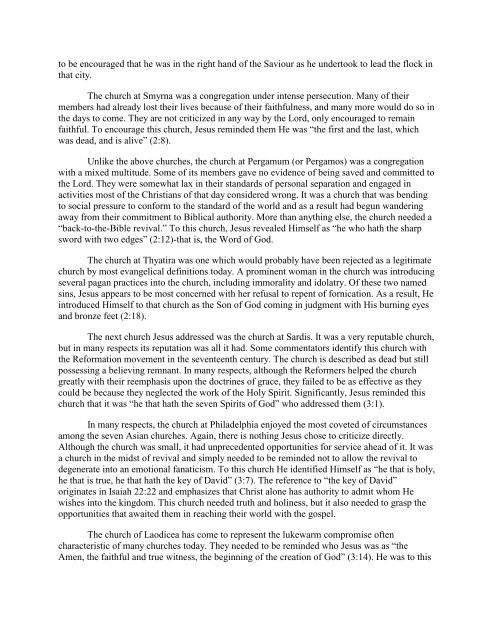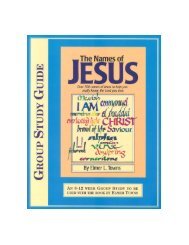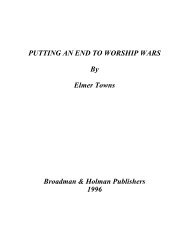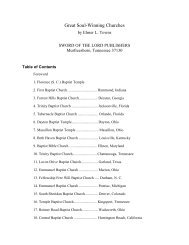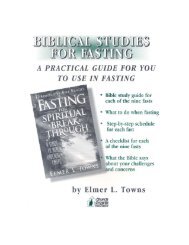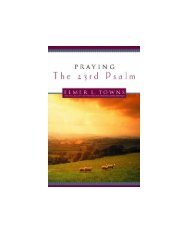The Names of Jesus - Elmer Towns
The Names of Jesus - Elmer Towns
The Names of Jesus - Elmer Towns
- TAGS
- elmer
- towns
- elmertowns.com
You also want an ePaper? Increase the reach of your titles
YUMPU automatically turns print PDFs into web optimized ePapers that Google loves.
to be encouraged that he was in the right hand <strong>of</strong> the Saviour as he undertook to lead the flock in<br />
that city.<br />
<strong>The</strong> church at Smyrna was a congregation under intense persecution. Many <strong>of</strong> their<br />
members had already lost their lives because <strong>of</strong> their faithfulness, and many more would do so in<br />
the days to come. <strong>The</strong>y are not criticized in any way by the Lord, only encouraged to remain<br />
faithful. To encourage this church, <strong>Jesus</strong> reminded them He was “the first and the last, which<br />
was dead, and is alive” (2:8).<br />
Unlike the above churches, the church at Pergamum (or Pergamos) was a congregation<br />
with a mixed multitude. Some <strong>of</strong> its members gave no evidence <strong>of</strong> being saved and committed to<br />
the Lord. <strong>The</strong>y were somewhat lax in their standards <strong>of</strong> personal separation and engaged in<br />
activities most <strong>of</strong> the Christians <strong>of</strong> that day considered wrong. It was a church that was bending<br />
to social pressure to conform to the standard <strong>of</strong> the world and as a result had begun wandering<br />
away from their commitment to Biblical authority. More than anything else, the church needed a<br />
“back-to-the-Bible revival.” To this church, <strong>Jesus</strong> revealed Himself as “he who hath the sharp<br />
sword with two edges” (2:12)-that is, the Word <strong>of</strong> God.<br />
<strong>The</strong> church at Thyatira was one which would probably have been rejected as a legitimate<br />
church by most evangelical definitions today. A prominent woman in the church was introducing<br />
several pagan practices into the church, including immorality and idolatry. Of these two named<br />
sins, <strong>Jesus</strong> appears to be most concerned with her refusal to repent <strong>of</strong> fornication. As a result, He<br />
introduced Himself to that church as the Son <strong>of</strong> God coming in judgment with His burning eyes<br />
and bronze feet (2:18).<br />
<strong>The</strong> next church <strong>Jesus</strong> addressed was the church at Sardis. It was a very reputable church,<br />
but in many respects its reputation was all it had. Some commentators identify this church with<br />
the Reformation movement in the seventeenth century. <strong>The</strong> church is described as dead but still<br />
possessing a believing remnant. In many respects, although the Reformers helped the church<br />
greatly with their reemphasis upon the doctrines <strong>of</strong> grace, they failed to be as effective as they<br />
could be because they neglected the work <strong>of</strong> the Holy Spirit. Significantly, <strong>Jesus</strong> reminded this<br />
church that it was “he that hath the seven Spirits <strong>of</strong> God” who addressed them (3:1).<br />
In many respects, the church at Philadelphia enjoyed the most coveted <strong>of</strong> circumstances<br />
among the seven Asian churches. Again, there is nothing <strong>Jesus</strong> chose to criticize directly.<br />
Although the church was small, it had unprecedented opportunities for service ahead <strong>of</strong> it. It was<br />
a church in the midst <strong>of</strong> revival and simply needed to be reminded not to allow the revival to<br />
degenerate into an emotional fanaticism. To this church He identified Himself as “he that is holy,<br />
he that is true, he that hath the key <strong>of</strong> David” (3:7). <strong>The</strong> reference to “the key <strong>of</strong> David”<br />
originates in Isaiah 22:22 and emphasizes that Christ alone has authority to admit whom He<br />
wishes into the kingdom. This church needed truth and holiness, but it also needed to grasp the<br />
opportunities that awaited them in reaching their world with the gospel.<br />
<strong>The</strong> church <strong>of</strong> Laodicea has come to represent the lukewarm compromise <strong>of</strong>ten<br />
characteristic <strong>of</strong> many churches today. <strong>The</strong>y needed to be reminded who <strong>Jesus</strong> was as “the<br />
Amen, the faithful and true witness, the beginning <strong>of</strong> the creation <strong>of</strong> God” (3:14). He was to this


